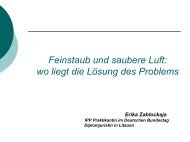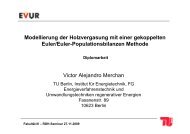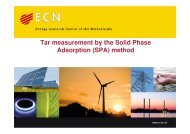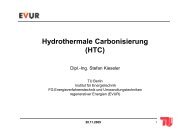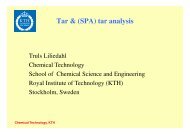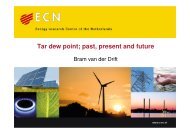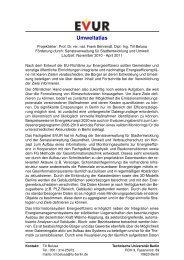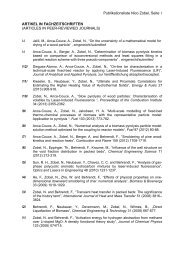Insert the title here - EVUR - TU Berlin
Insert the title here - EVUR - TU Berlin
Insert the title here - EVUR - TU Berlin
Create successful ePaper yourself
Turn your PDF publications into a flip-book with our unique Google optimized e-Paper software.
In our review <strong>the</strong> trend of increasing stakeholder involvement can be underlined. 17 out of 34<br />
articles showed a direct involvement of stakeholders in <strong>the</strong> respective case study or a tool that<br />
is built for a future participation of stakeholders. As an example <strong>the</strong> ARTEMIS project can be<br />
given (Kowalski08, Omann08; Madlener07): In a national case study representatives of<br />
different interest groups and energy experts evaluated energy scenarios. Two workshops and<br />
25 interviews for <strong>the</strong> purpose of scenario development and for <strong>the</strong> deliberation of criteria and<br />
weights were conducted.<br />
3.4. Real world application:<br />
The criteria real world application were not analysed with <strong>the</strong> first reviews done by Huang et<br />
al. and Pohekar et al.. Kowalski et al. offer that information in <strong>the</strong>ir review without going into<br />
a detailed discussion.<br />
In our review it can be seen that most of <strong>the</strong> case studies published are real world applications<br />
according to our definition that <strong>the</strong> decision process could be applied to <strong>the</strong> corresponding<br />
region and <strong>the</strong> results could be implemented. 28 out of 35 articles are showing real world<br />
applications. The remaining “not real world case studies” are ei<strong>the</strong>r mere comparison of<br />
technologies such as (Afghan04) or (Zhou07) or approaches, which are still on a more<br />
abstract level but under preparation for a future real world case study as (Buchholz 07).<br />
However, <strong>the</strong> fact that nearly all articles publish real world case studies does not show that <strong>the</strong><br />
decision process was realized. T<strong>here</strong> are just a few articles, which clearly mention that <strong>the</strong><br />
alternatives identified by <strong>the</strong> MCDA process were actually implemented. The case study by<br />
Ben Salah et al. is presenting a tool that decides whe<strong>the</strong>r a domestic apparatus should be<br />
connected ei<strong>the</strong>r to <strong>the</strong> electrical grid or to a photovoltaic panel (BenSalah08). This tool<br />
decides and implements <strong>the</strong> decision automatically so that implementation is always a<br />
necessary consequence. Fur<strong>the</strong>r <strong>the</strong> above introduced local case study within <strong>the</strong> ARTEMIS<br />
project in Austria showed recommendations, which <strong>the</strong> communities planned to implement<br />
after <strong>the</strong> MCDA decision process was accomplished (Kowalski08, Omann08; Madlener07).<br />
Most of <strong>the</strong> case studies provide recommendations or decision tools for politics or for local<br />
energy utilities without giving evidence of an actual realization.<br />
Ano<strong>the</strong>r indication for <strong>the</strong> real world potential of MCDA is <strong>the</strong> involvement of companies<br />
compared to a mere research environment. Many case studies integrate companies for<br />
interviews or workshops (e.g. Neves08) but <strong>the</strong>re are no companies clearly mentioned that<br />
ordered <strong>the</strong> MCDA decision process. However, case studies such as (Wijayatunga06) indicate<br />
a jointly conduction with companies. In this case <strong>the</strong> Sri Lanka Energy Managers Association<br />
was involved for an evaluation of strategies to overcome barriers for cleaner production<br />
technologies.<br />
Compared to that <strong>the</strong> publication by Hobbs and Meyer in <strong>the</strong> year 2000 “Energy Decisions<br />
and <strong>the</strong> environment: A guide to <strong>the</strong> use of multicriteria methods” offers several case studies<br />
that were conducted at companies such as Canadian and American Utilities (Hobbs00).<br />
T<strong>here</strong>fore, it is quite possible that <strong>the</strong>re are fur<strong>the</strong>r real world case studies that are ordered and<br />
conducted by companies but have not been published in <strong>the</strong> scientific literature. Also <strong>the</strong><br />
company that sells <strong>the</strong> software of <strong>the</strong> MCDA method AHP “expert choice” publishes a list of



